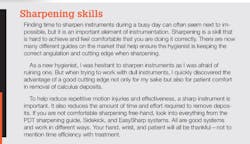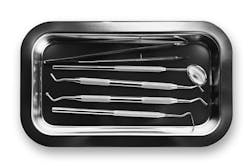The not-so-small role of instrumentation: The reality about dental hygiene's tools of the trade
By Jamie Collins, RDH, CDA
Both new and seasoned hygienists will always come across that patient who challenges our clinical instrumentation skills. We spent all that time in school learning the “optimal” everything from adaptation of scalers and Graceys to ultrasonic use only to find in the real world it doesn’t always apply in every circumstance. Let’s face it, we become creative or sometimes need to adapt to a less than ideal situation. Being able to adapt while accessing the pocket to disrupt the biofilm and remove deposits requires clinicians to have a strong knowledge of root morphology and techniques - and think outside of the box.
It’s easy to develop less than ideal habits, and those habits stick with us if we are not careful. Those bad habits may lead to bigger concerns than just improper instrumentation techniques. Whether you were educated when ergonomics was emphasized or not, without the basics of instrumentation and ergonomics, there is an increased risk of injury with the development of bad habits.
From time to time, I have found myself trying anything possible to reach the distal of a maxillary second or third molars on the patient who can’t seem to open and won’t let you lay the chair back more than a forty-five degree angle. Sound familiar? When we get back to fundamentals of hygiene and start to think about everything from adaptation, pressure and stroke, and ergonomics, it provides a great reminder on how to provide optimal patient care and ensure a longer career for the hygienist.
One important item I use clinically every day without exception is my loupes. Magnification is a crucial element to providing optimal patient care. I have used the same pair of Orascoptic loupes for well over a decade and feel like I couldn’t do my job without them. They are well used but worth their weight in gold. I added an illumination system about eight years ago and feel it has stepped up my abilities as a clinician in addition to reducing eye fatigue by the end of the day. Having the ability to see what I feel with tactile sensation - and not having to squint or hunch to read the markings on the probe - saves not only eye strain but also reduces neck and back discomfort. Loupes and illumination are one of the best investments I have made in my career and would encourage every hygienist to do the same.
Fulcrum techniques
For stability and safety, we always fulcrum while scaling, choosing a correct and comfortable fulcrum to alleviate pressure on the wrist and reduce muscle fatigue. Moving beyond the simple to an advanced fulcrum, whether intraoral or extraoral, will create easier access with better adaptation potential. Using the ring finger on the opposing arch of the posterior being scaled allows the clinician to keep the instrument parallel while scaling. By using this cross-arch intraoral fulcrum, it helps to keep the wrist alignment neutral while allowing access to scale deeper pockets with the instrument parallel to the root surface as desired.
Using a chin-cupping fulcrum may also be useful when removing tenacious deep calculus deposits on the maxillary arch, I often use this in conjunction with those patients who inadvertently close down while I am working. The subtle reminder of my hand cupping the chin helps them to stay open during treatment all while providing a stable fulcrum.
When you change the fulcrum, you often need to make an adjustment to the grasp on the instrument as well. As the modified fulcrum is further away from the tooth being scaled than a simple fulcrum, the clinician’s hand should slide further away from the shank of the instrument to allow full access to the periodontal pocket as needed.
The adaptation will depend on the instrument being used since different instruments have varying strengths, angulations, and lengths. Choosing the correct instruments for the desired site and severity of periodontal disease will make the therapy most effective. Most instruments are designed to be used with the terminal shank parallel to the root or crown of the tooth instrumented.
How to choose a rigid, a mini, or an extended access curette comes with experience and preference. In general, a rigid would be used in pockets with heavy calculus deposits, an extended access curette is used in deep pockets where a longer terminal shank is needed. Like every item out on the market, we find our “favorites” whether it be a brand or an instrument type. I have tried many over the years and find subtle differences that vary by manufacturer - not all Gracey 11/12s are created the same. My clinical setups include a variety of instruments from different manufacturers. Some brands I have used for years, and some I have recently discovered.
Reaching the base of the pocket of the distal of a second or third molar can sometimes be a challenging task. When there is a periodontal disease involvement, it can be hard to access with a traditional method. One of my favorite instruments to use in these cases is a Gracey 15/16 or 17/18 with the toe toward the gingiva utilizing a horizontal stroke with a non-traditional fulcrum, going from buccal to lingual line angle or vice versa. This allows adaptation for removal of calculus deposits and biofilm disruption in the difficult area.
Along the lines of non-traditional instrument adaptation comes the curse of the fixed orthodontic retainer. You know the one that is cemented on each anterior tooth. As a hygienist I love that it is placed to hold the arch, but cringe when it comes to cleaning around it. Over time I had learned that you can use a posterior scaler in the anterior with great efficiency in many cases. The orthodontic retainers can attest to that. I will use a variety of hand instruments to complete removal of calculus deposits. I use a variety of anterior scalers and curettes and often will also utilize my Barnhart 5/6 to tuck under the retainer wire as applicable to get some of those hard to reach spaces that my anterior scaler may not easily access.
Implant Maintenance
Dental implants are becoming more common as individuals want to restore something that has been lost, and implants allow those teeth and function to be replaced. As we all know, implants can not get decay but can be susceptible to periodontal disease. They pose a different kind of challenge to adequately treat in office.
The titanium implant does not tolerate normal scalers that are used in the rest of the mouth, and specific probes and curettes must be used with care to not scratch the surface of the implant. Gone are the days when we had to use the plastic instruments to clean around implants. It seemed like we were using a plastic spoon and it was hard to adapt. Now we have a variety of titanium instruments specially made to adapt to implants. One of my favorite sets for implant instruments I have discovered is from Deppeler, a Swiss-based company. The instruments have angulations that adapt easily between the gingiva and implant post making even the most challenging implant accessible.
Removal of calculus from an implant is hard to achieve without a good instrument to work with; you are only as good as your tools allow you to be.
Implants are not the only challenge in a daily schedule. What percentage of the patient population in your day have some degree of furcation involvement? How do you clean into a furcation and adapt an instrument into the difficult area? Again, with the right instruments, it can make it easier to provide care. Some companies have now created a line of instruments to adapt to the root surface and have a fine diamond coating to lightly smooth the root surface after scaling. Like my implant instruments, I have a set of furcation instruments for these difficult areas that I occasionally use to ensure the best care I can provide.
A complete periodontal screening and probing should be completed and recorded annually. In my opinion, spot probing should be checked at each and every dental hygiene visit, especially when a patient has had a change in health or has areas that are being “watched.” Do not wait until those pockets become a 5 or 6 millimeter pocket until they are treated adequately. Find and treat the cause of the localized inflammation. Is it subgingival calculus or the ever elusive popcorn that is impacted. Having the skills to adapt to the root surface and often it may be in a manner that was not taught in hygiene school and often require a little creativity to access the base of the pockets and root adaptation.
As a hygienist, some of us have the ability to choose instruments when ordering or replacing worn or broken ones. With so many choices on the market, I look at everything from the working end and thickness to the overall balance of the instruments. We work with our hands all day, and fatigue can set in. Having the ability to change what we can to alleviate stress and reduce the fatigue is worth the investment. Choosing a larger diameter handle that may be round or hexagon shaped and a well-balanced instrument can help alleviate muscle fatigue in the hands. When choosing an instrument, I like to hold it and feel the weight and balance, experiencing how it fits my hand and comfort level.
Using loupes, well sharpened instruments, and being body conscious while scaling, a hygienist can increase the chances of a long career all while providing the best care possible to each and every patient.
The field of dental hygiene is changing as we focus on whole body health. Someone we may have seen for years and has been “easy” now may present with sudden changes in oral health. As I see those patients, I often ask pointed questions to try and find out what has changed in their overall health or stress levels. With a large percentage of the adult population afflicted with some form of periodontal disease, having the skills to provide confident and competent periodontal therapy is an expected standard. Many times this can be related to a systemic disease such as diabetes, and with the ever increasing rate of diagnosed cases the challenge of oral care will continue.
Like fingerprints, no two mouths are the same; therefore, the same treatment does not necessary apply to all patients we see in the day. Having the ability to provide advanced care utilizing methods that we learn throughout our careers and thinking outside of the box allows us to provide the best care possible. RDH
Jamie Collins, RDH, CDA, resides in Idaho with her husband, Cory, and their four children. She currently works as a full-time hygienist as well as an educator at the College of Western Idaho. In addition, she acts as a content expert and contributor in multiple upcoming textbooks. She can be contacted at [email protected].


